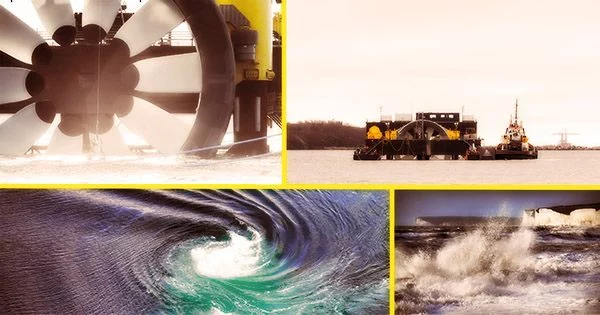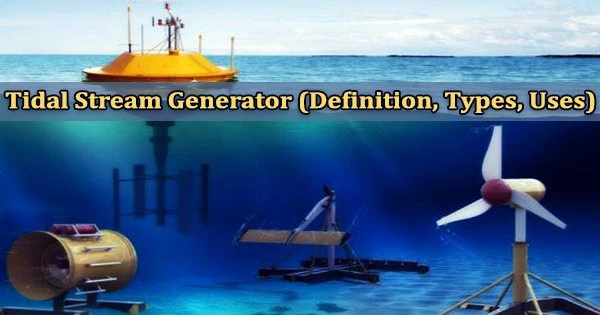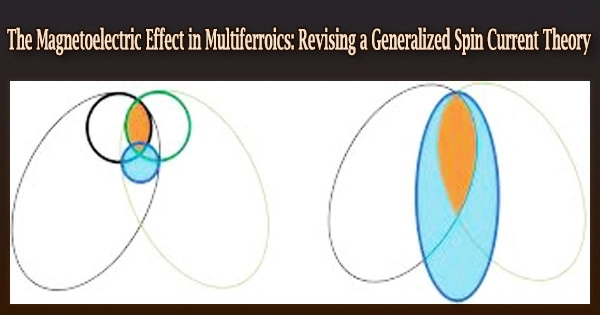Similar to how a wind turbine uses wind to produce power, a tidal stream generator, also known as a tidal energy converter (TEC), harnesses the kinetic energy of moving water to drive a turbine. Although the phrase is frequently used to refer to devices designed to collect energy from run-of-river or tidal estuarine settings, it is a machine that extracts energy from moving quantities of water, in particular tides.
The rush of ocean waters that occurs during tidal rise and fall is known as tidal energy. It is a renewable energy source. However, because water has a higher density than air, tidal power generating capacity in a particular area may be larger than that of a wind turbine. These devices are sometimes referred to as tidal turbines since some of them operate very similarly to underwater wind turbines. They were first conceived in the 1970s during the oil crisis.
The least expensive and environmentally harmful of the four primary types of tidal power generating are tidal stream generators. Tidal energy is a renewable source of power generated by the tidal movements and ocean currents that occur naturally. These technologies include paddles and turbines, among others.
The following discussion will cover the various distinct types of tidal stream producers. These generators are mostly or entirely submerged and have very little visible impact.
Similar to how wind turbines obtain energy from air currents, tidal stream generators obtain energy from water currents. However, a single tidal turbine may have a higher capacity for power production than a wind energy turbine with a same rating. In regions where there is a sizable variation in area between high tide and low tide, engineers devised ways to exploit tidal movement to create energy during the 20th century.
Each technique turns tidal energy into electricity using specialized generators. When compared to equivalent wind speeds, a single generator can provide a large amount of electricity at low tidal flow velocities because water has a higher density than air (water is about 800 times the density of air).
Given that power varies with medium density and the cube of velocity, water speeds that are almost a tenth that of wind provide the same power for a turbine system of the same size. However, this restricts the application in practice to locations where tide speeds are at least 2 knots (1 m/s), even during neap tides. Tidal energy production is still in its infancy. The amount of power produced so far has been small.
There aren’t many commercial-scale tidal power facilities in operation worldwide. A tidal turbine can normally access four times as much energy per rotor swept area as a wind turbine with a similar rated power at higher speeds in a flow of seawater between 2 and 3 meters per second.

All forms of tidal power technologies have extremely large upfront expenditures, and it takes a long time to recoup those costs. Seawater is also highly corrosive, which raises maintenance expenditures. Among a wide range of concepts, no conventional tidal stream generator has emerged as the clear victor.
Many businesses have made big promises about a number of prototypes that have showed promise, some of which have not yet been independently validated, but these prototypes have not yet been used commercially for long enough to determine their performances and rates of return on investment. Due to the fact that the sector is still in its infancy, research data on stream generators and their power output are currently limited.
Axial (horizontal) turbines
The rotor of axial turbines is parallel to the water stream coming in. These resemble conventional windmills in principle but work underwater. Due of the different fluid characteristics of water and air, they use modified rotors similar to those used in wind turbines.
These devices use the lift of water to generate power. This calls for specifically formed surfaces that turn the turbine, known as airfoils. This produces a net force that is perpendicular to the direction of the water flow, turning the device. To preserve their ability to capture the power of the tide as it varies, rotors of this sort must be correctly positioned (the orientation is referred to as the rotor pitch). European technology and innovation platform for ocean energy (ETIP OCEAN) Powering homes today, Powering nations tomorrow report 2019 makes note of record volumes being supplied through tidal stream technology.
Cross-flow turbines
Cross-flow turbines have a rotor that is parallel to the water’s surface and perpendicular to the water flow, which emerges as a sheet. Instead than only having flow in the direction of motion, these turbines also have water flowing across the axis (across the flow of water, hence the name).
These turbines, which Georges Darreius created in 1923 and received a patent for in 1929, can be set up either vertically or horizontally. These machines normally produce power by the drag of the water, unlike axial turbines. Water pressure pushes against a surface in drag-based turbines, much as wind on an open sail. This works because the turbine blade’s open face has more drag than its closed face does. Because they function in relation to the relative flow speed of the water, drag-based devices are fundamentally less effective than their lift-based equivalents. This means that as a turbine rotates faster the water will come out going faster (more kinetic energy leaving the system in the water) and the turbine won’t extract as much of the fluid’s energy. While this system is less efficient (especially for high velocity situations), it’s other advantages can outweigh this inefficiency (operates well with low hydraulic head and they’re simple to construct).
Flow augmented turbines
The incident power available to a turbine can be enhanced by using flow augmentation techniques, such as a duct or shroud. The most typical example uses a shroud to boost the axial or crossflow flow rate through the turbine.
The Australian company Tidal Energy Pty Ltd undertook successful commercial trials of efficient shrouded tidal turbines on the Gold Coast, Queensland in 2002. Tidal Energy delivered their shrouded turbine in northern Australia where some of the fastest recorded flows (11 m/s, 21 knots) are found. Two small turbines will provide 3.5 MW. Another larger 5 meter diameter turbine, capable of 800 kW in 4 m/s of flow, was planned as a tidal powered desalination showcase near Brisbane Australia.
Vertical axis turbines
The rotor of a vertical axis turbine is perpendicular to the incoming water flow and vertical to the water’s surface. These turbines can use blades of both the lift and drag types. Because horizontal axis wind turbines are more prevalent than vertical axis wind turbines, this type of turbine is less well known to the general public.
Vertical axis wind turbines have been in use for a while, despite the general lack of familiarity. Also take note of the fact that these specific tidal stream generators are mounted on the top rather than the bottom. The advantage of this style of turbine is that the tidal flow can come from different directions, and motion can still be harnessed for electricity. This is similar to the advantage of a vertical axis wind turbine.
Oscillating devices
Oscillating devices lack a rotating component; instead, the current flow pushes these generators back and forth or up and down to form a hydraulic pump. During 2003 a 150 kW oscillating hydroplane device, the Stingray tidal stream generator, was tested off the Scottish coast. The Stingray generates oscillation by the use of hydrofoils, which enables it to generate hydraulic power. A hydraulic motor that turns a generator is then powered by the hydraulic energy.
This type of system must be fastened to bottom of the ocean floor. Of course, this kind of fastening would be different for this kind of tidal technology. In the Humber Estuary, Pulse Tidal runs an oscillating hydrofoil machine known as a Pulse generator. They have funding from the EU and are creating a commercial scale that will be operational in 2012.
Legal issues of underwater land ownership and environmental impact exist in the United States. Tidal energy does not excite investors because there is little assurance that it would generate profits or benefit customers. In order to produce more energy, lessen their negative effects on the environment, and help energy firms turn a profit, engineers are attempting to advance the technology of tidal energy generators.
















